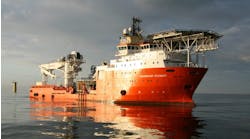David Colliard, Jérôme Anton - Acergy France SA
The second paper highlighted from the floaters/construction track reviews typical suction pile designs based on recent deepwater projects in West Africa, emphasizing geotechnical analyses and critical installation-related aspects. Design approaches and data from field cases of suction pile installation are presented and analyzed.
Over the last decade, the industry has been preparing recommended practices and design codes for sizing of suction piles, and geotechnical designs have been carried out following state-of-the-art methods. On the structural and functional side, innovative solutions have been developed for designing installation aids and connection systems subsea-operated by ROVs.
In the Gulf of Guinea, deepwater developments often take place in large seabed areas of the continental slope. These seafloors generally present a regular bathymetry and consist of relatively uniform soil conditions in terms of nature (clays) and mechanical characteristics (very soft to soft within the depth of interest).
In such conditions, suction pile is the solution of preference if a unique concept is elected for all structures to be founded, primarily because suction piles can be designed to transfer all types of efforts (horizontal, downward vertical, upward vertical) from structures to the ground. Having only one type of foundation saves on the mobilization of suitable installation equipment and allows standardization of the installation methods.
Despite their different geographical locations and water depths, soils in the West African regions have strong similarities in their geotechnical properties. This is the main outcome of an extensive joint research project involving Acergy France, among others, that has been conducted by reviewing soil data from 10 deepwater sites offshore Nigeria, Equatorial Guinea, Congo, and Angola.
The comparison with normalized data from the Gulf of Mexico shows significant differences between the two regions. Also, the West African deepwater soils disclose mechanical behavior that questions the applicability of the most common soil mechanics theory.
Having set up a framework for the expected geotechnical properties of Gulf of Guinea soils, this work is currently being extended to focus on the interface properties of these clays with applications such as suction piles and flowlines.
Nevertheless, it already provides a useful database for the geotechnical engineer drawing preliminary designs from few available soil data when new fields are developed. The key points characterizing the Gulf of Guinea deepwater sediments are:
- Very high plasticity related to the mineralogic nature of the clay particles
- Thixotropic properties
- Low permeability
- Relatively high shear strengths as compared to their unit weights.
Site-specific data, acquired with appropriate tools and testing, are still required. However, there is no need to increase the number of soil borings or in situ tests up to the number of suction piles in such uniform sites. Little gain in foundation reliability can be expected from extensive seabed investigations as long as design uncertainties are properly addressed.
Suction pile design
Suction piles are large-diameter hollow steel cylinders (referred to as skirt), open-ended at bottom and closed at top, with a large range of applications as foundation structures.
The term suction refers to the method of installation, which implies sucking out the water entrapped in the pile once it has been penetrated into the seabed under its self weight, in order to drive it down to its design penetration. Once target penetration has been achieved, the top of the pile is fully closed (vent hatches, hot stab suction ports are sealed). There is no active suction maintained, but as the top is closed, any uplift load will create an under-pressure within the pile that tends to suck the soil into the can, giving considerable foundation capacity.
Generally, what determines the size of the suction pile is primarily the required balance between the design loads applied and the soil resistance with the selected pile geometry. Also, suction pile design must comply with several functionality requirements, which can be related to installation or in-place conditions, such as:
- Installation tolerances, which depend on installation vessel and means, including seabed marking and transponder array coverage
- Installation aids for orienting and performing the suction operations (ROV-operated installation requires proper docking structures on top of the pile)
- Location of the load application point, which affects suction pile design on both geotechnical and structural sides
- Interaction with other structures/flowlines (i.e., it may be required that the suction pile load application point satisfies a displacement criteria for the whole field life, or that suction piles are so closely installed that there is an interaction in-between; displacement criteria may govern the pile sizing).
Design challenges
The design of suction piles is barely straightforward, and as illustrated by the examples shown above, significant dimension and weight differences can be found depending on the variables input to the design.
The scope of suction pile design covers:
- Definition of the geotechnical parameters for design from field survey data
- Preliminary sizing of the suction pile
- Refined finite element analyses for holding capacity/displacement final checks
- Installation and retrieval analyses
- Structural design for all phases (pre-service, in-place, fatigue), using finite element analyses where necessary
- Installation aids enabling suction operations performed with ROV
- Detailed fabrication drawings
- Requisition, procurement, and tracking of all materials and equipment from suppliers to yard delivery.
Suction pile design is the right balance between the installation constraints and the in-place foundation requirements. Pile diameter and height are driven by design criteria relating soil strength and loads. Pile wall thickness is imposed by the inner can over- or under-pressure structural criteria or necessary reinforcements at attachment point.
This paper continues with a discussion of foundation sizing using limit equilibrium models, finite element analyses, and the Abaqus code for total stress analyses. Structural sizing and buckling assessment and installation records conclude this comprehensive overview of suction piles.
The authors note that these concepts have been used in the Gulf of Guinea for developments in water depths in the range 500-1,500 m, adding there is virtually no barrier to have it applicable to water depths beyond. Therefore, suction piles are likely to follow future developments in ever-increased water depths fields in Gulf of Guinea, as it is already a reality in other parts of the world.


